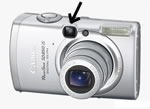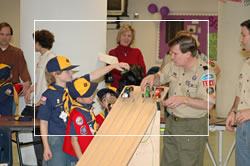Features |
Previous  Next Next |
Last Updated: December 28, 2007
Photo Quality in Various Conditions
No matter how many features you have or don't have, you want a camera that takes a good picture. If you only take scenery pictures on sunny days, then any camera will do. Few cameras take good pictures indoors, outdoors, in bright light, low light, nighttime, action, still, macro, and don't have a red eye problem or purple fringing problem (chromatic aberration).
Optical image stabilization
This reduces the number of blurry photos in low light situations. I wouldn't buy a point and shoot camera without it.
Optical Viewfinder
 |
In bright sunlight, the LCD screen on the back of the camera is too dim to see. You can't tell what your photographing. Some cameras have an optical viewfinder (see arrow) to assist in taking the photo. I wouldn't buy a point and shoot camera without it. |
Megapixels
 |
An 8 megapixel camera doesn't necessarily take a better photo than a 3 megapixel camera. The quality of the lens and the quality of the image sensor have more of an impact on overall quality than the number of megapixels. However, the number of megapixels makes a difference when a photo is cropped. The photo on the left shows half of the megapixels inside the white box and half outside. On an 8 megapixel camera, the remaining 4 megapixels could produce an 8×10 and a borderline 10×14 photo. On a 6 megapixel camera with 3 megapixels remaining, an 8×10 is the limit. |
| Photo Size(Inches) | Megapixels of Camera | |
| 300dpi* Photos | 200dpi* Photos | |
| 3×5 | 1.4 | 0.6 |
| 4×6 | 2.1 | 1.0 |
| 5×7 | 3.2 | 1.4 |
| 8×10 | 7.2 | 3.2 |
| 10×14 | 12.6 | 5.6 |
| 16×20 | 28.8 | 12.8 |
* dpi is dots per inch.
Megapixel calculation: (photo width × dpi) × (photo height × dpi) / 1,000,000.
Better Photos with SLR Cameras
Most of the limitations of a point and shoot camera go away with a SLR camera with removable lenses. The quality of the photos is much better with a SLR, but the cameras are bigger and more expensive. The biggest limitation of a point and shoot camera is the quality of the lens, red eye, and focus lag time.
Sharper Photos with a Quality Lens
The quality of the lens will make a difference in the quality of the photo. It's one of the most overlooked, but important features of a camera. Unfortunately, there aren't any standardized tests or measurements to quantify lens quality.
Concentrate on the optical zoom rating and ignore the digital zoom rating. An optical zoom will always give you a better picture than a digital zoom. A 3X zoom is standard.
There's a big quality difference between a point and shoot camera and a SLR camera with a kit lens. The photo has more detail and appears to be more in focus. There is also a big quality difference between a kit lens or other consumer grade lens and a professional grade lens. Again, the photo has more detail and appears to be more in focus. Typically, the best pictures come from the largest and most expensive lenses.
Red Eye
Red eye is caused when the flash is too close to the lens. Photo editing software can take out red eye with a few mouse clicks, but that's a lot of work when there are dozens of photos to edit. All of the Canon PowerShot models along with models from other manufacturers include red eye removal in the camera. This is a huge time saver. Here are examples of shots with and without the feature.
 |
Canon PowerShot SD850 IS with red eye removal turned OFF. Photo courtesy of Digital Camera Resource Page (near bottom of page) |
 |
Canon PowerShot SD850 IS with red eye removal turned ON. Photo courtesy of Digital Camera Resource Page (near bottom of page) |
Focus Lag Time
Most cameras take one second to focus from the time the shutter button is pressed to the time the picture is taken. Many now come with a prefocus feature where you can press the shutter release button half way down to focus. When you are ready to take the picture, press the shutter release button the rest of the way down to take a picture in 1/10th of a second. This allows you to capture more action shots and facial expressions.
Auto Focus Assist Lamp
In dark conditions, there isn't enough light for the auto focus to work. Even in manual focus, it's too dark to tell if you're in focus or not. The auto focus assist lamp turns on a light on the front of the camera for it to focus either in auto or manual modes. This is a "must have" feature.
Manual Override Controls
Manual override controls include manual focus, aperture settings (f-stop), shutter speed, and ISO setting. If you want more control with taking photos, chose a camera over $200 with these features.
ISO Sensitivity
Cameras come with an ISO sensitivity rating. The higher the number, the more sensitive it is to light and the better it will work in dark places or fast action. ISO 400 is standard. ISO 100 or 200 will have a difficult time taking indoor photos without a flash or tripod. Cameras produce more noise (graininess) at higher ISO numbers. Night time photos look best if the camera allows you to manually set the ISO to a lower number to get a cleaner looking picture.
Manual White Balance
Cameras automatically adjust for the lighting condition so white will appear as white rather than off-white. White on a bright day looks different than on a cloudy day or under florescent lights. The camera can sometimes guess the wrong lighting conditions. A manual white balance will allow you to correctly calibrate the camera if it is having difficulties. If you take indoor photos without a flash, then a manual white balance will remove the color cast before the photo is taken. It saves time so that the photo doesn't have to be corrected in Photoshop.
JPEG or RAW?
All digital cameras save photos using the JPEG file format. The files have a .JPG file name extension. This format compresses the photo to a small file size so that more photos will fit on a memory card. JPEG is a "lossy" format since it throws away colors to obtain a smaller file size. The amount of compression can be changed on the camera and usually appears as a quality setting. A lot of colors are discarded for a low quality setting and a few colors are discarded for a high quality setting.
All SLR (Single Lens Reflex) cameras with removable lenses can save the photo in the RAW file format. Other cameras with non-removable lenses may save the photo in either the RAW or TIFF file format. TIFF is not compressed while the RAW format is compressed to a smaller file size. Both RAW and TIFF are a "lossless" format which means none of the colors have been thrown away.
The RAW file format contains all of the data the camera captured and compresses it into a single file. None of the colors are discarded. The RAW file is 1.5 to 2 times larger than the highest quality JPEG file, but itís still smaller than a non-compressed TIFF file. Photoshop Elements, Photoshop CS2/CS3, and a few other applications are able to convert RAW photos to another format, but the software that came with the camera is the only one guaranteed to edit the settings of a RAW file. The software will allow you to change the white balance, exposure compensation, flash compensation, sharpening, or any other camera setting. The results are better than using Photoshop.
Professional photographers recommend saving photos in the RAW or TIFF file format instead of using JPEG. The next photo could be your next 16"×20" (40cm×75cm) masterpiece.
I now shoot in RAW since I color correct every photo with a white balance card. Color cast was bothering me enough to make the switch from JPEG to RAW. It now takes longer to upload photos to this website, butI think the difference is worth it. It may not be worth it to you.